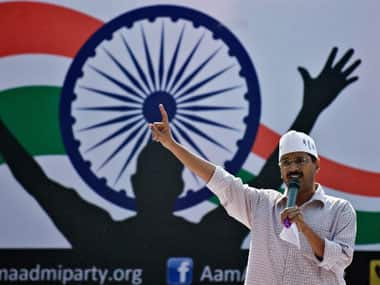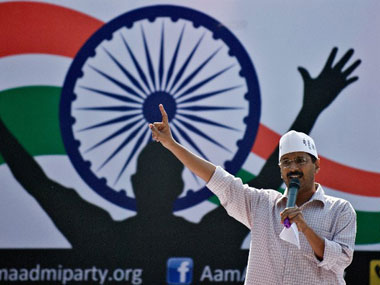First he was endorsed by Pratap Bhanu Mehta, and soon after, by none other than Shobhaa De. Now India Today has accorded Arvind Kejriwal the super-star treatment– including the de rigeur photo-shoot that produced the Arvind-as-boxer cover image. All that’s missing is a rap moniker to confirm his new media darling avatar. [Not available online] The cameras may have loved Anna and his sea of adoring crowds back in the Jantar Mantar days, but the Delhi media establishment has long been ambivalent about the charms of a hot-headed, mousy bureaucrat. At the height of the Lokpal mania, Kejriwal was painted at best as a cantankerous political genius, and at worst, a scheming puppeteer. Two years later, skepticism has given slowly way – in the face of indisputable on-the-ground success – to hearty enthusiasm. The perfume of popularity can make even an ‘angry anarchist’ irresistible to the media elite. Hence, Arvind the giant-killer, dressed up in bantam red, ready to sock one in the eye of Sheila Dixit. [caption id=“attachment_1184475” align=“alignleft” width=“380”]  Arvind Kejriwal. AFP.[/caption] But the Arvind on the cover is at odds with the Arvind inside the pages. The Kejriwal followed around by assistant editor Asit Jolly is no lean, mean pugilist, but a calm and careful pragmatist. “You cannot run a state through referendums. What I am saying is that there must be people’s participation in governance, which is very different from a referendum,” he says in an attempt to tamp down fears about radical swaraj. And no, he’s no wild-eyed lefty opposed to market capitalism, either. “We are not wedded to any ideology. We have problems and want solutions” – whether they come from the left or right, Kejriwal insists. He wants everyone to know that he supports market capitalism and private enterprise; the role of the government is to “act as an honest regulator and watchdog to protect the interests of the disadvantaged.” These statements are not, in fact, signals of a national agenda – not yet – but part of a campaign to blunt the attacks of his detractors who paint him as a wild-eyed radical. As for example India Today’s S Prasannarajan, who in the same issue describes him as “a factory-assembled revolutionary who is part Gandhian, part Marxist, part anarchist, part libertarian”. This rather unlikely ideological combination is, of course, entirely the creation of the paranoid imagination of Kejriwal critics who ascribe all strands of known extremism to Kejriwal – and at times, as in this case, all at once. Prasannarajan’s paranoia enables the dizzying leaps of interpretation required to discern in Kejriwal’s populist rhetoric, the seeds of a dystopian future that would make the average Maoist blush. “In the post-revolution Ruritania, ’every aam aadmi will be the government,’ and where justice will be ‘dispensed to the common man at his doorstep,’ most likely after a show trial at the village square,” he warns darkly, reading extensively outside the lines of Kejriwal’s quotes. Kejriwal, unfortunately for Prasannarajan, appears determined to make such wildly imaginative analysis more difficult to sustain. Take, for instance, his latest Economic Times interview which ranges from the mildly snarky to downright diplomatic. On foreign affairs: “Currently, we are fighting Delhi elections and foreign affairs isn’t something that we have to deal with. Maybe you put this question to Mayawati or Mulayam Singh Yadav, who might become the next Prime Minister of the country. " Rahul vs Modi for PM: “That’s for the people of this country to decide. You are asking me this question too early.” Gujarat Riots? “The riots were obviously bad. Modi is certainly guilty of polarising the people of Gujarat at the time of riots. But both Congress and BJP are parties that create their votebank by communalising issues.” Where, oh where, is everyone’s favorite fire-breathing demagogue? Forget Ruritania, Kejriwal isn’t even willing to promise Ram Rajya: “But having said that, people’s expectations from the party have become really big and that scares me sometimes. Unko lagta hai ki humare aane se Ram Rajya aa jayega (they feel that we will establish an ideal state). But now I have started telling them that I don’t have a magic wand and it takes time to bring in change.” This gentler, more rational incarnation is far more frightening to Kejriwal critics who prefer him as he was during the Lokpal agitation: thin-skinned, defensive, using moral fervor to compensate for a dead-end political strategy. And it is also why he is increasingly palatable to both a Shobhaa De and a Pratap Bhanu Mehta; and why the phoolwala in Khan Market tells India Today that 9 out of 10 customers plan to vote for AAP.
To blunt the attempts of his critics to paint him as an extremist, Kejriwal has dialled down the moral fervour and reinvented himself as a calm, careful pragmatist.
Advertisement
End of Article


)
)
)
)
)
)
)
)
)



